Nerve Supply Of Lower Limb Question And Answers
Question 1. Give an outline of the nerve supply of the lower limb.
Answer:
Nerve Supply Of The Lower Limb
- The nerves of lower limb originate from:
- Lumbar plexus (L1-L4)
- Sacral plexus (L4-S4)
- Three main nerves originate from the plexus and innervate the lower limb. They are:
- Femoral nerve: Nerve of the anterior compartment of the thigh.
- Obturator nerve: Nerve of the medial compartment of the thigh.
- Sciatic nerve: Nerve of the posterior compartment of thigh.
Mnemonics
- Thgh: Innervation by compartment ‘MAP OF Sciatic’:
- Medial compartment: Obturator
- Anterior compartment: Femoral
- Posterior compartment: Sciatic
So all the thigh muscles in that compartment get innervated by that nerve.
- The sciatic nerve divides into the tibial nerve and the common peroneal/common fibular nerve, a little above the popliteal fossa.
- The tibial nerve divides into:
- Medial plantar nerve
- Lateral plantar nerve.
- Common peroneal/common fibular nerve divides into:
- Superficial peroneal nerve
- The deep peroneal nerve.
- The tibial nerve divides into:
Read And Learn More: Anatomy Question And Answers
Question 2. Explain in detail about the femoral nerve under the headings—origin, root value, beginning, course, termination, branches, and innervation.
Answer:
Femoral Nerve
It is the nerve of the anterior compartment of the thigh.
Femoral Nerve Origin
- Largest branch of lumbar plexus.
Femoral Nerve Root Value
- L2, L3, L4
Femoral Nerve Beginning
- Emerges at the lateral border of psoas major in the abdomen.
Femoral Nerve Course
- It enters the thigh posterior to the inguinal ligament just lateral to the femoral sheath.
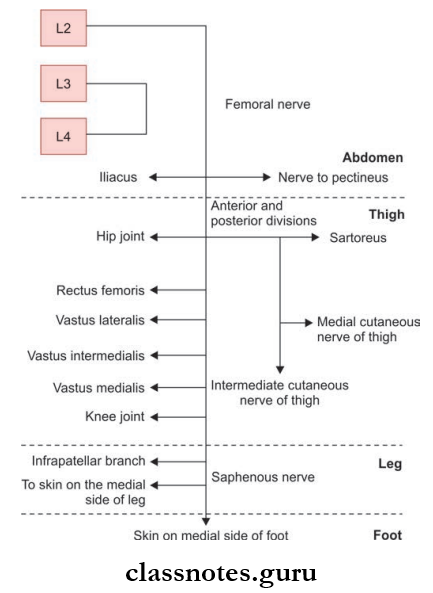
Femoral Nerve Termination
- Below the level of the inguinal ligament, it divides into anterior and posterior divisions separated by the lateral circumflex femoral artery.
Femoral Nerve Branches and Innervation

Femoral Nerve Clinical Anatomy
- Rarely in stab wounds in the groin region, the femoral nerve can get injured and paralysis of the quadriceps femoris with or without loss of sensation on the anterior and medial aspects of the thigh can occur.
Question 3. Explain in detail about the obturator nerve under the headings—origin, root value, beginning, course, termination, branches, and innervations.
Answer:
Obturator Nerve It is the chief nerve of the medial compartment of the thigh.
Obturator Nerve Origin
- From lumbar plexus.
Obturator Nerve Root Value
- L2, L3, L4
Obturator Nerve Beginning
- Emerges from the medial border of the psoas major muscle within the abdomen.
- It crosses the pelvic brim and runs downwards through the obturator foramen.
Obturator Nerve Termination
- The obturator nerve terminates after exiting through the obturator canal by dividing into anterior and posterior divisions.
Obturator Nerve Branches and Innervations
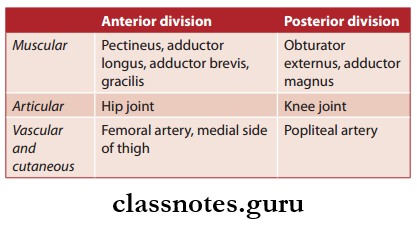
Obturator Nerve Clinical Anatomy
- In disease to the knee joint, pain may get referred to hip joint also because the obturator nerve supplies both joints.
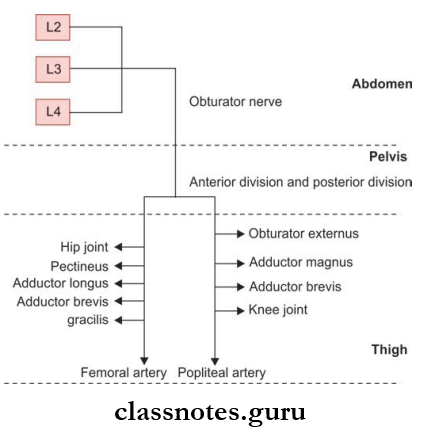
Question 4. Explain in detail about the sciatic nerve under the headings—origin, root value, beginning, course, termination, relations, branches, and innervations.
Answer:
Sciatic Nerve
- Sciatic Nerve is the thickest nerve in the body.
- Sciatic Nerve is the nerve of the posterior compartment of the thigh.
Sciatic Nerve Origin
- Arises from sacral plexus.
Sciatic Nerve Root Value
- L4, L5, S1, S2, S3.
Sciatic Nerve Beginning
- From pelvis.
Sciatic Nerve Course
- The sciatic nerve leaves the pelvis by passing through the greater sciatic foramen below the piriformis muscle and enters the gluteal region.
- From the gluteal region, it runs downwards with slight lateral convexity between the ischial tuberosity and greater trochanter.
- At the lower border of the gluteal maximus, it enters the back of the thigh and runs vertically downwards up to the superior angle of the popliteal fossa.
Sciatic Nerve Termination
- The sciatic nerve splits to the tibial and common peroneal nerve at the level of the upper 2/3rd and lower 1/3rd of the thigh.
Sciatic Nerve Relations
- Deep relations: From above downwards:
- Body of ischium
- Tendon of obturator internus
- Quadratus femoris
- Adductor magnus.
- Superficial relations: From above downwards:
- Gluteal Maximus
- Long head of biceps femoris.

Sciatic Nerve Branches and Innervations
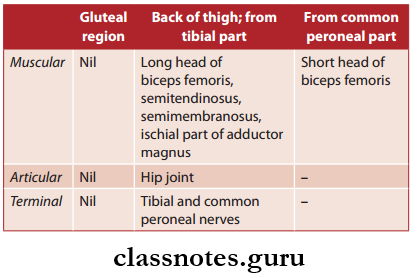
Sciatic Nerve Clinical Anatomy
- When a person sits on a hard surface for a longer time, compression of the sciatic nerve leads to paresthesia of the lower limb known as sleeping foot
- When compression of the nerve root of the sciatic nerve occurs, the patient complains of shooting pain along the cutaneous distribution of the sciatic nerve. The pain starts in the gluteal region, then back to the thigh, then the lateral side of the leg, and to the dorsum of the foot.
Question 5. Explain in detail about the common peroneal nerve under the headings—origin, root value, beginning, course, termination, branches, and innervations.
Answer:
Common Peroneal Nerve Origin
- Common Peroneal Nerve is a smaller terminal branch of the sciatic nerve.
Common Peroneal Nerve Root Value
- L4, L5, S1, S2.
Common Peroneal Nerve Beginning
- Begins as a smaller terminal branch of the sciatic nerve in the back of the thigh.
Common Peroneal Nerve Course
- Common Peroneal Nerve descends downwards along the medial side of the tendon of the biceps femoris up to the lateral angle of the popliteal fossa.
- Common Peroneal Nerve further descends downwards to turn around the lateral surface of fibula.
- The rest of the nerve lies in the substance of the peroneus longus muscle.
Common Peroneal Nerve Termination
- Terminates as superficial and deep peroneal nerves.
Common Peroneal Nerve Branches and Innervations
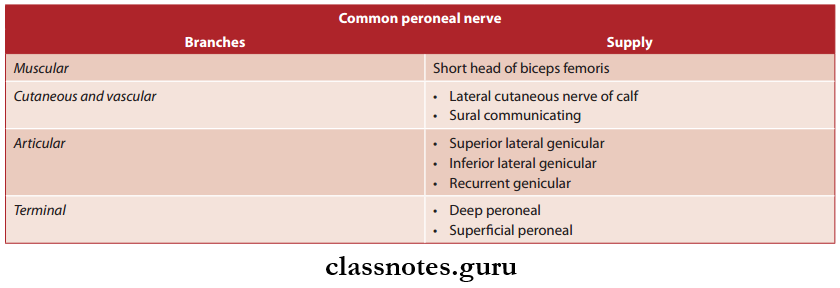
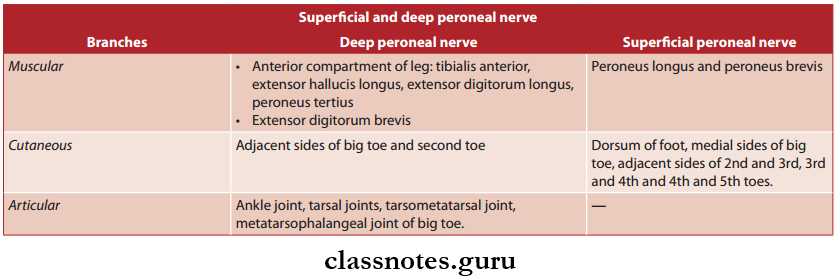
Common Peroneal Nerve Clinical Anatomy
- Injury to the common peroneal nerve causes ‘foot drop’ and the person has a stepping gait.
Question 6. Explain in detail about the tibial nerve under the headings—origin, root value, beginning, course, termination, branches, and innervations.
Answer:
Tibial Nerve Origin
- Tibial Nerve is a large terminal branch of the sciatic nerve.
Tibial Nerve Root Value
- L4, L5, S1, S2, S3.
Tibial Nerve Beginning
- Larger subdivision of the sciatic nerve in the back of the thigh.
Tibial Nerve Course
- Tibial Nerve runs vertically downwards from the superior angle to the inferior angle of the popliteal fossa.
- In the popliteal fossa, it crosses the popliteal artery from the lateral to the medial side, superficial to it.
- The Tibial Nerve descends downwards to the back of the leg as a neurovascular bundle along with the posterior tibial artery and passes deep to the flexor retinaculum.
Tibial Nerve Termination
- Tibial Nerve terminates as medial and lateral plantar nerves as it lies deep in the flexor retinaculum.
Tibial Nerve Branches and Innervations

Tibial Nerve Clinical Anatomy
- Tarsal tunnel syndrome is caused by compression of the tibial nerve in the tarsal tunnel.
Question 7. Explain in detail about the cutaneous innervations of the lower limb.
Answer:
The Cutaneous Innervations Of The Lower Limb
Cutaneous supply of the lower limb originating from the lumbar and sacral plexus. In addition, T12, and L1 spinal segments also provide nerve fibers for the cutaneous supply.

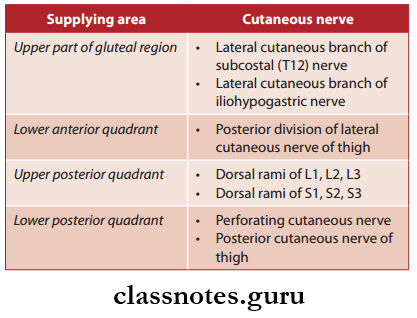
Anterior Aspect of Thigh
- Seven cutaneous nerves supply skin of the front of thigh.
- They are emerging from the lumbar plexus.
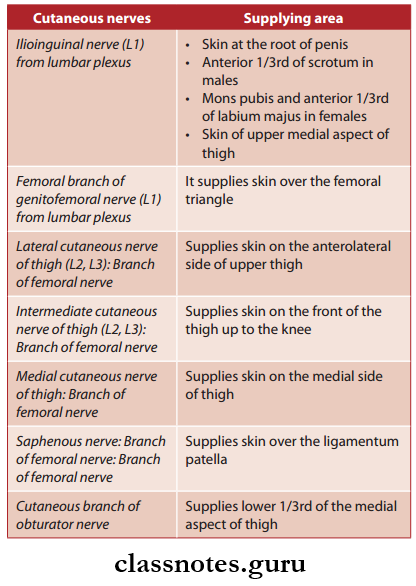
Medial Aspect of Thigh
- Cutaneous branch of the obturator nerve.
- The medial cutaneous nerve of the thigh—a branch of the femoral nerve.
Posterior Aspect of Thigh
- The Posterior Nerve Of The Thigh: Direct branch of sacral plexus.
Patellar Plexus
- The skin over the patella, ligamentum patellae, and upper end of the tibia are supplied by a plexus of nerves around them.
- These are formed from branches from:
- The lateral cutaneous nerve of the thigh
- The intermediate cutaneous nerve of the thigh
- The medial cutaneous nerve of thigh
- Infrapatellar branch of the saphenous nerve.
Front, Dorsum, Lateral, and Medial Side of Leg
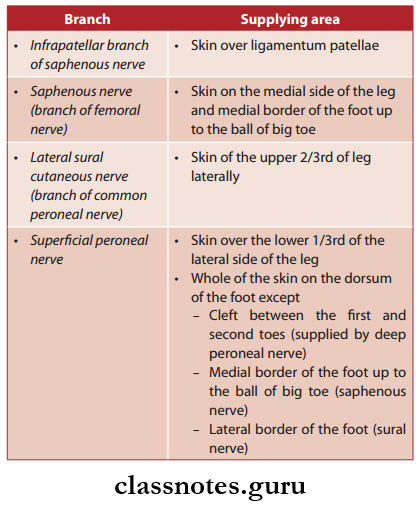
Back Of Leg

Sole Of Foot
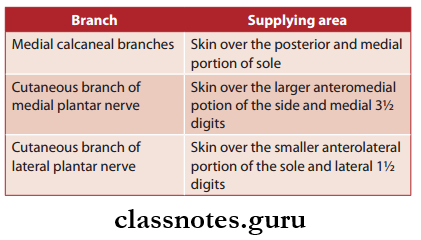
Clinical Anatomy
Sometimes in obese or elderly people, the lateral cutaneous nerve of the thigh may get compressed by the inguinal ligament in its course and may present with pain and numbness over the anterolateral aspect of the thigh called meralgia paresthetica.
Question 8. Draw the dermatomes of the lower limb
Answer:
The Dermatomes Of The Lower Limb

Nerve Supply Of Lower Limb Multiple Choice Questions
Question 1. Which is not a branch of the common perineal nerve?
- Lateral inferior genicular
- Recurrent genicular
- Sural
- Sural communicating
Answer: 3. Sural
Question 2. Which dermatome is located over the medial border of the foot?
- S1
- S2
- L4
- L5
Answer: 3. L4
Question 3. Which nerve is tested if a physician pinches the skin of a patient between big toe and the second toe?
- Superfiial perineal
- Deep perineal
- Sural
- Saphenous
Answer: 2. Deep perineal
Question 4. The lateral cutaneous branch of the following nerves enters the gluteal region:
- Subcostal and iliohypogastric
- Subcostal, ilioinguinal and iliohypogastric
- Subcostal and ilioinguinal
- Iliohypogastric and ilioinguinal
Answer: 1. Subcostal and iliohypogastric
Question 5. Foot drop can be caused due to the injury of:
- Obturator nerve
- Femoral nerve
- Sciatic nerve
- Anterior tibial nerve
Answer: 3. Sciatic nerve
